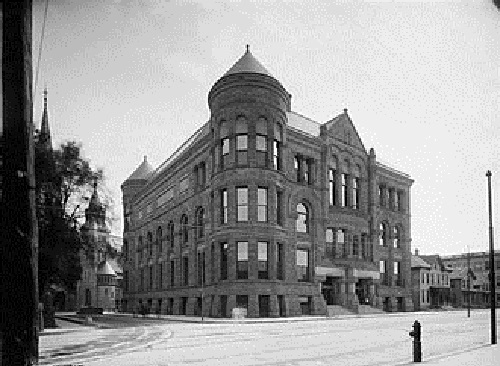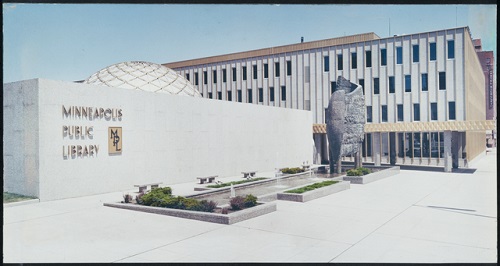The Minneapolis Central Library
 Tuesday, May 21, 2019 at 3:32PM |
Tuesday, May 21, 2019 at 3:32PM |  Michael Rainville Jr |
Michael Rainville Jr | Article by Michael Rainville, Jr.
The largest library in Hennepin County, the Minneapolis Central Library, houses the third largest per capita public library collection of any major city in the United States, with a collection of more than 2.4 million items. A remarkable resource for residents in the area. Education is important for the growth of any city, and libraries have been anchors for many communities throughout Minneapolis.
Before the city’s library system came to be, there was a subscription library founded in 1859 and charted as a corporation in 1860 called the Minneapolis Athenaeum. Other subscription libraries popped up around the area during this time, such as the St. Anthony Literary Society and the Mechanics Library. However, the Athenaeum was the only one able to find success. Years later in 1865 they constructed their own building located in the heart of a fledgling Minneapolis called Centre Block, which is where Gateway Park currently lies. In 1885 the Athenaeum partnered with the newly created Minneapolis Public Library and has been associated with them ever since. Their collection is housed in vaults located on the 4th floor Special Collections Department of the current Minneapolis Central Library.
 Original library, 1900
Original library, 1900
After four years of existence, the Minneapolis Public library opened its first central library in 1889, and it was situated along 10th Street and Hennepin Avenue. The main attraction of this new castle-like building was the art collection of T.B. Walker, the namesake for the Walker Art Center. Just as the city of Minneapolis was rapidly growing throughout the 20th century, so was the library, and in 1961 the Minneapolis Public Library and Information Center opened along 4th Street and Nicollet Avenue. This location was chosen in order to be a cornerstone for a very run-down Gateway District that was in the process of being redeveloped thanks to the 1960’s Urban Renewal project that impacted some of the larger cities throughout the United States.
 Second library, 1961
Second library, 1961
The new building included a library, planetarium, auditorium, and a museum in its basement that was known for its Egyptian mummies. The planetarium was without a doubt a hit with children and adults alike. It was operated by the Minneapolis Planetarium Society, and from 1974-1982 they partnered with the Science Museum of Minnesota to jointly run the planetarium that saw over 170,000 visitors per year during its early years, and over four million during its entire lifespan. Unfortunately, good things come to an end and the city was without a planetarium once the Minneapolis Public Library and Information Center closed its doors in 2002 to make way for a brand-new building. Initially the plan was to construct a planetarium on top of the new building, but plans fell through and in 2011 the Minneapolis Planetarium Society merged with the Bell Museum of Natural History. Everything ended up working out for everyone, as a state-of-the-art planetarium is included in the new Bell Museum that opened in July of 2018.
 Rendering of the current library with the planetarium on the roof.
Rendering of the current library with the planetarium on the roof.
Now back to the library. In the 1990s, city and library officials recognized that the downtown community was outgrowing the current building, technology was rapidly improving, and the library’s collection was growing by the day, so the process of planning a new one began. In November of 2000 the citizens of Minneapolis voted to approve a $140 million funding to improve the library. Almost six years later in May of 2006, the Minneapolis Central Library you see today opened to the public. Designed by César Pelli, who is known for designing the Petronas Towers in Kuala Lumpur and the World Financial Center in New York City, the new library features many windows to allow natural light in, a rooftop garden, an Adaptive Technology Lab, homework tutoring for K-12 students, and a beautiful collection of art that is spread throughout the building. The Minneapolis Central Library has been vital for the educational growth of the city and its residents since it first opened it doors, and three buildings later it shows no signs of slowing down.
- - - - - - - - - - - - - - - - - - - - - - - - - - - - - - - - - - - - - - -
 About Michael Rainville, Jr.
About Michael Rainville, Jr.
A 6th generation Minneapolitan, Michael Rainville Jr. received his B.A. in History from the University of St. Thomas, and is currently enrolled in their M.A. in Art History and Certificate in Museum Studies programs.
Michael is also a lead guide at Mobile Entertainment LLC, giving Segway tours of the Minneapolis riverfront for 6+ years.
He can be reached at mrainvillejr@comcast.net.
